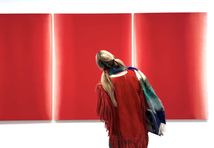Art Market Paragone by Matthew Biedermann
- The Courtauldian
- Aug 10, 2023
- 4 min read
26 Oct 22
In the Italian Renaissance, humanist writers, armed with a revised interest in Greek and Roman antiquity, became obsessed with the concept of paragone. Literally meaning comparison, this rhetorical debate would pit painting and sculpture against each other, each party to the debate attempting to demonstrate which art form was superior. The culmination of this battle occurred in the early years of the 16th century at the Palazzo Vecchio in Florence, where the unrivalled painter, Leonardo da Vinci, was set against Michelangelo, the supreme sculptor, to create the best fresco history painting to adorn the wall of the Hall of Five Hundred.
A sort of paragone lives on today, in the pages of the art world newspapers, where pundits endlessly debate the relative status of the global art capitals. New York versus London for control of the anglophone world, London versus Paris for European capital, New York versus Miami for American capital, Hong Kong versus Seoul for Asia—in this accounting, the art world operates as a zero-sum game, where there can only be one winner, the capital with the most cultural capital.
The United Kingdom’s recent woes, starting with Brexit and enduring through the Johnson premiership and Liz Truss’s 46 days in the desert, have positioned London as the most vulnerable art world capital and subject to persistent declinist description. Long gone are the days where anyone would consider comparing London’s art market to New York’s, and even Paris appears to threaten London’s historic place as the European art market’s entrepôt. In this telling, art market participants are voting with their feet, with more prominence given to Sotheby’s and Christie’s Paris auctions and new outposts being opened by the big four galleries. Gagosian opened its first Paris location last September in the 1st arrondissement, following David Zwirner’s first Continental outpost, which opened in the 3rd arrondissement in 2019.
In the post-Brexit environment, a continental migration such as this is expected, mirroring moves in other white-collar industries such as financial services, where international businesses can no longer rely on London to operate as their outpost in the European Union. This shift is seemingly quantified in the Art Market Report published annually by Art Basel, written by Dr Clare McAndrew. In 2020, London’s public auctions captured 16% of the global market, compared to Paris’s 13%. In 2021, these figures were 13%-9%, suggesting that Paris is indeed catching up to London.
This October, the two cities were placed in direct competition in a manner evocative of Leonardo’s battle against Michelangelo. Frieze, London’s indigenous art fair, took place just a week before the inaugural Paris+ par Art Basel fair, precipitating headlines such as “Paris vs London: which capital will win the hearts of art collectors?” seen in The Art Newspaper. This battle of art forums sought to draw out every point of comparison between the two cities, from their museums and gallery scenes to their liveability, cleanliness, and even relative currency strength.
However, this Renaissance style comparison seems slightly out of place in today’s environment. Charting the notable differences between these cities obfuscates the many similarities between global capitals, as the process of globalisation blends international cities into facsimiles of each other. Note that as institutions such as Sotheby’s and Gagosian expanded into the Parisian market, they did not close down their London locations. It is not an indigenous art fair that is trying to usurp Frieze’s London position as the most visible European venue, but Art Basel, who now holds fairs in other global cities like Hong Kong and Miami.
The process seen here could be described as the ‘Aman Effect’, after the exuberantly luxurious global resort chain. Aman properties have sprung up in an environment where the wealthiest global citizens are prone to travel to, and each property is significant in so much as they are clones of each other. Splash out for what is now Manhattan’s most expensive hotel room at Aman New York, and you immediately forget which continent you are on—let alone which city. Aman demonstrates an intriguing trait demonstrated by the jet-setting elite; in that they desire a certain similitude anywhere they go. Other brands which cater to this demographic, such as Cipriani, operate on a similar brief. Harry’s Bar is no longer merely a Venetian bar famed for Hemmingway and Bellinis, but rather a brand which exists away separate from its auratic origin, operating in New York and London, catering to the same clientele. The fashion world has long embraced this globalised simulacrum, where the storefronts of Mayfair are now indistinguishable to those of the Champs Élysées or 5th Avenue.
It is not that London is being eclipsed by Paris, but that the art world is finally catching up to the reality of their client base which other industries catering to high income individuals already know—art buyers now demand the same brands and services wherever they go. The competition for their spending is not predicated on difference but on similarity. Squint, and the differences between art market players like Christie’s and Sotheby’s, or Gagosian and David Zwirner, are no longer identifiable, just as the distinctive characteristics of cities like London and Paris are blended into a globalised playground for the wealthy.












Comments